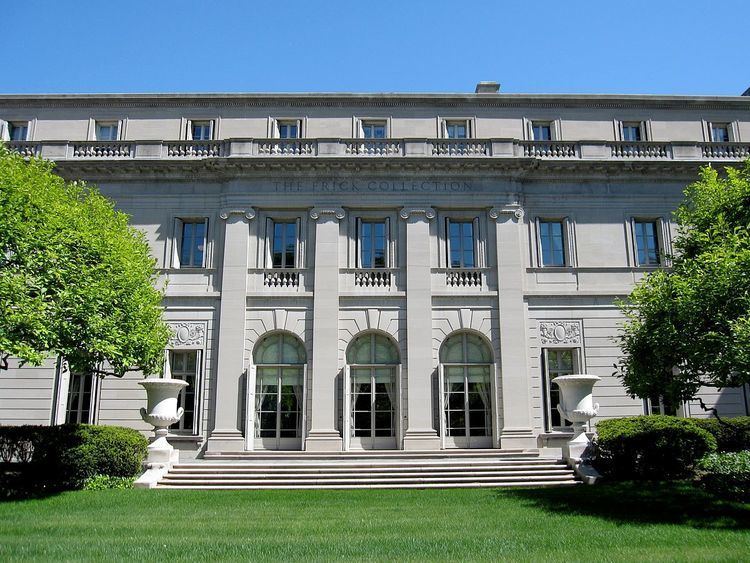Established 1935 | Type Art Director Ian Wardropper | |
 | ||
Location 1 East 70th Street
Manhattan, New York City Public transit access Subways: at 68th Street – Hunter College station
Buses: M1, M2, M3, M4, M66, M72, M98, M101, M102, M103 Address 1 E 70th St, New York, NY 10021, USA Hours Open today · 10AM–6PMFriday10AM–6PMSaturday10AM–6PMSunday11AM–5PMMondayClosedTuesday10AM–6PMWednesday10AM–6PMThursday10AM–6PM Artwork Officer and Laughing Girl, St Francis in Ecstasy, Girl Interrupted at Her Mu, Mistress and Maid, Portrait of Sir Thomas More Profiles | ||
Introduction to the frick collection
The Frick Collection is an art museum located in the Henry Clay Frick House on the Upper East Side in Manhattan, New York City at 1 East 70th Street, at the northeast corner with Fifth Avenue. It houses the collection of industrialist Henry Clay Frick (1849–1919).
Contents
- Introduction to the frick collection
- Tour of upstairs rooms at frick collection
- History
- Collection
- Attendance
- Governance
- Funding
- Artworks
- References
Tour of upstairs rooms at frick collection
History
Henry Frick started his substantial art collection as soon as he started amassing his fortunes. A considerable amount of his art collection is located in his former residence "Clayton" in Pittsburgh, which is today a part of the Frick Art & Historical Center. Another part was given by his daughter and heiress Helen to the Frick Fine Arts Building, which is on the campus of the University of Pittsburgh.
The family did not permanently move from Pittsburgh to New York until 1905. Henry Frick initially leased the Vanderbilt house at 640 Fifth Avenue, to which he moved a substantial amount of his collection. He had his permanent residence built between 1912 and 1914 by Thomas Hastings of Carrère and Hastings. He stayed in the house until his death in 1919. He willed the house and all of its contents, including art, furniture, and decorative objects, as a public museum. His widow Adelaide Howard Childs Frick, however, retained the right of residence and continued living in the mansion with her daughter Helen. After Adelaide Frick died in 1931, the conversion of the house into a public museum started.
John Russell Pope altered and enlarged the building in the early 1930s to adapt it to use as a public institution. It opened to the public on December 16, 1935.
Further expansions of the museum took place in 1977 and in 2011. In 2014, the museum announced further expansion plans, but came up against community opposition because it would result in the loss of a garden. The Frick ultimately dropped those plans and is said to be considering other options.
Collection
The Frick is one of the pre-eminent small art museums in the United States, with a high-quality collection of old master paintings and fine furniture housed in six galleries within the former residence. Frick had intended the mansion to eventually become a museum. Many of the paintings are still arranged according to Frick's design. Besides its permanent collection, the Frick has always organized small, focused temporary exhibitions.
The collection features some of the best-known paintings by major European artists, as well as numerous works of sculpture and porcelain. It also has 18th century French furniture, Limoges enamel, and Oriental rugs. After Frick's death, his daughter, Helen Clay Frick, expanded the collection, with a third of its artworks acquired since 1919. Although the museum cannot lend the two-thirds that belonged to Frick, as stipulated in his will, the Frick Collection does lend artworks and objects acquired since his death.
Included in the collection are Jean-Honoré Fragonard's masterpiece The Progress of Love, three paintings by Johannes Vermeer including Mistress and Maid, two paintings by Jacob van Ruisdael including Quay at Amsterdam, and Piero della Francesca's St. John the Evangelist.
Attendance
According to The Art Newspaper, the Frick Collection has a typical annual attendance of 275,000 to 300,000. About 35 percent of the visitors are non-English speaking.
Governance
In 2011, Ian Wardropper succeeded Anne Poulet, who had run the Frick Collection as director since 2003. Poulet took the position after Samuel Sachs II stepped down after running the institution for six years. Poulet was the first female director of the Frick. During her time at the Frick Collection, Poulet increased the museum’s small board of trustees, adding 10 new members. She also introduced the Director’s Circle, a group of 44 members who each give a minimum of $25,000 a year to the Frick Collection, although many have made significantly larger contributions.
Funding
The Frick Collection has an operating budget of $10 million and an endowment of $170 million (as of 1997). Despite its large endowment, the institution still needs money to preserve the building.
Artworks
Featured artists include:
